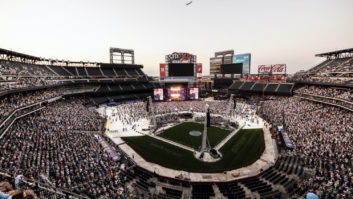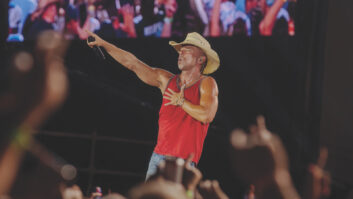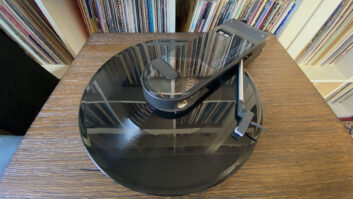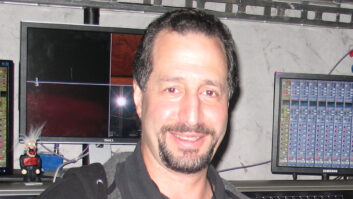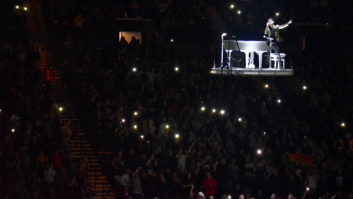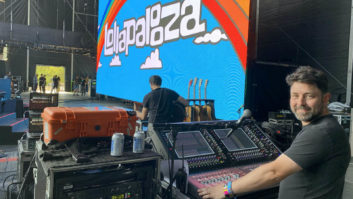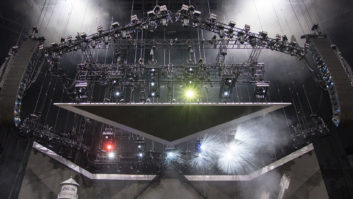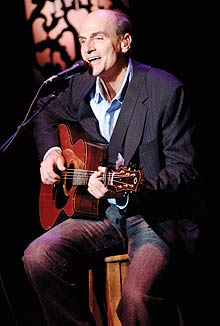
Photo: Tim Mosenfelder
James Taylor’s One Man Band tour isn’t quite as solitary as the name implies. There are, after all, other players onstage: The talented Larry Goldings accompanies him on piano, keyboards and harmonium; and an imposing drum machine that looks like it was handmade from a closet full of Rube Goldberg’s spare parts makes a pair of appearances. The Tanglewood Festival Chorus (including Taylor’s wife, Kim) also joins the show, collaborating with him via video screens during “My Traveling Star” and “Shower the People.”
Playing rooms as large as 3,600 seats but making most stops in venues built for 2,500 to 2,700, Taylor’s current pared-down approach to touring is, as he says, “An intimate retrospective of 40 years’ worth of songs and the people, places and events that inspired them.” The One Man Band performances weave a full 20-song concert set with a rich narrative that draws from six decades in the artist’s life. Illustrated with photos, drawings and more from Taylor’s private archives, the monologue provides a time line and reveals the back-stories and inspirations behind the songs.
“The audience gets to hear all the songs,” notes David Morgan, the show’s front-of-house audio engineer; Andy Sottile handles monitor engineering duties. “They share in everything from a look at James’ old black-and-white photos and home movies to stories of past girlfriends and adventures. There are plenty of opportunities for fun, too.”
Morgan began working with Taylor during the artist’s 2005 Summer’s Here tour. Since March of 2006, Taylor has alternately traveled either with his full band or as a one-man act. The one-man show was captured for release on DVD this past summer by Sydney Pollack and Don Mischer when Taylor performed at the Colonial Theatre in Pittsfield, Mass.
THE VOCAL APPROACH
“The first thing I wanted to examine when I came into this was his vocal sound,” Morgan recalls. “He had been using a wide-pattern cardioid mic, an AKG 535, for quite a while, and had made a switch to in-ear monitors some time ago. I always try to put myself in the performer’s place. We used the 535 for the four background vocalists on Whitney Houston in 1986 and 1987, so I know it pretty well. It’s a great-sounding mic, but it lets in a lot of the outside world. I reasoned that if I were James, I’d want a vocal mic a bit more suited for use with my in-ears, a mic exhibiting greater off-axis rejection while still producing a rich and accurate sound.”
In 2004, Morgan latched onto a pair of new unmarked prototype mics from Shure: One was a cardioid, the other a supercardioid. Morgan first used the supercardioid model on backing vocalist Margaret Dorn while touring with Bette Midler.
“It had a realistic vocal quality to it I had never experienced with a microphone designed for live sound applications,” Morgan recalls. “It was clear, transparent, sweet sounding, quite honest and it worked well in Margaret’s in-ears. Quite often with a tight-patterned mic, off-axis info comes back hard and distorted, but that wasn’t true with this one. I went and listened with ear buds to what she was hearing, and the background info sounded amazingly true.”
While he was working on Taylor’s Summer’s Here tour, Morgan’s no-name microphones began being called KSM9s. By the time he showed up at One-Man Band rehearsals in 2006, he was using production model KSM9s.
THE GUITAR SOUND
Taylor engages his audience with a pair of Olson acoustic guitars: a full-bodied concert model and a cutaway. A Telecaster makes an appearance for “Chili Dog” and “Steamroller,” but the Olsons get the most use onstage.
The Telecaster is routed through a Line 6 PODxt Proa, which, according to Morgan, “works fine for this purpose, giving us a nice, distorted, bluesy sound without destroying the acoustic vibe of what’s going on. We didn’t want a single amp onstage.”
Conversely, each of Taylor’s acoustic guitars is outfitted with L.R. Baggs LB6 Series pickups. A unitary pickup and saddle commonly used by large-venue performers over the years, the LB6 is used with a Radial Engineering Tonebone PZ-Pre preamp leading into a Fishman Aura Acoustic Imaging Blender. “This combination gives a dimensionality to the instrument that enhances the illusion of space,” Morgan explains. “Taking this route was all part of our never-ending search for reality; the strings sound as if they are resonating in wood, not across a crystal. Making an acoustic guitar sound real is a major sound reinforcement challenge.”

Front-of-house engineer Dave Morgan at the Digidesign VENUE D-Show Profile board, which he has found perfect for Taylor’s theater tour.
NEXT UP, PIANO
Morgan faces a similar dilemma every time he mikes the tour’s 7.5-foot Yamaha C7 grand piano, which is played with the lid closed. To deal with this issue, Morgan devised a system based around a pair of Shure KSM44s, an Applied Microphone Technology M40 piano mic and a Barcus-Berry piano pickup.
“One KSM44 is placed on the low-end side just above the area where the strings cross,” Morgan explains. “The other is on the high end, miking the smallest hole on the soundboard slightly off-center so that you hear a little ambience, too. The Barcus-Berry goes in the second largest hole in the soundboard, and the M40 goes all the way down to the nose of the piano, facing back at the hammers.”
At the bottom end, the KSM44 favors a good, strong left hand, and in turn the Barcus-Berry adds high-frequency sparkle. Morgan predominantly bandpasses the M40 for low-mid warmth, while the second KSM44 over the small soundboard hole brings out high-mids. Atlas clamps hold the latter in place, along with gaffer’s tape; a piece of Ozite carpet protects the piano from the clamps’ setscrews.
“Each of the transducers adds its own unique component to the sound,” Morgan adds. “It’s like having a four-way crossover inside the piano. If you think about it, a closed-lid piano is somewhat of a contradiction, but is often a fact of life in a sound reinforcement situation. The instrument was meant to be played open. Add up the characteristics of these components, though, and it sounds real again.”
IN THE HOUSE
With input from the stage taken care of, Morgan’s choice for bringing sound to the audience fell upon Clair Bros.’ i3 line arrays. The enclosures are three-way in configuration and pack a pair of 12-inch LF transducers topped-off by twin 6-inch compression drivers. Morgan calls the enclosures “sweet-sounding boxes — the vocal sound that comes out of them, as well as that of the acoustic guitar, is absolutely perfect for the format we are representing and the venues in which we are performing.”
Morgan mixes on a Digidesign VENUE D-Show Profile console, a compact board he’s found well suited to the smaller theater aisles he’s constantly negotiating. Describing the VENUE plug-ins as sounding like “equipment that could only exist in a dream a few years ago,” he feels as if he’s in a toy land, where he can pick from a full range of vintage compressors, reverbs and more. “All the wonderful stuff we used to see in studios in days gone by, equipment that would cost you a mint in rentals, are not pieces of gear you want to take on the road and break anyway. The whole VENUE console concept is geared around running a live show. You don’t have to divert your attention or think too much to use it as a mixing platform.”
Morgan’s mix takes aim at trying to give the audience the impression that they’re sitting in their own living room listening to a personalized concert. While quite a few effects are used in the show to obtain the realism for which Morgan is constantly striving, he stresses their judicious use.
“I was fortunate early on to have a mentor who gave me the greatest advice I ever got,” Morgan confides. “Whenever you use an effect, bring it up to where you can hear it, then back it down a little. Along with that bit of shared insight, also remember that equalization usually isn’t about adding what you want, but rather taking away what you don’t need. All the artistry and subtlety of audio engineering really revolves around those two tips, and they serve me well as guideposts on this show, too.”
Nick Russell is a freelance writer in Chicago.
